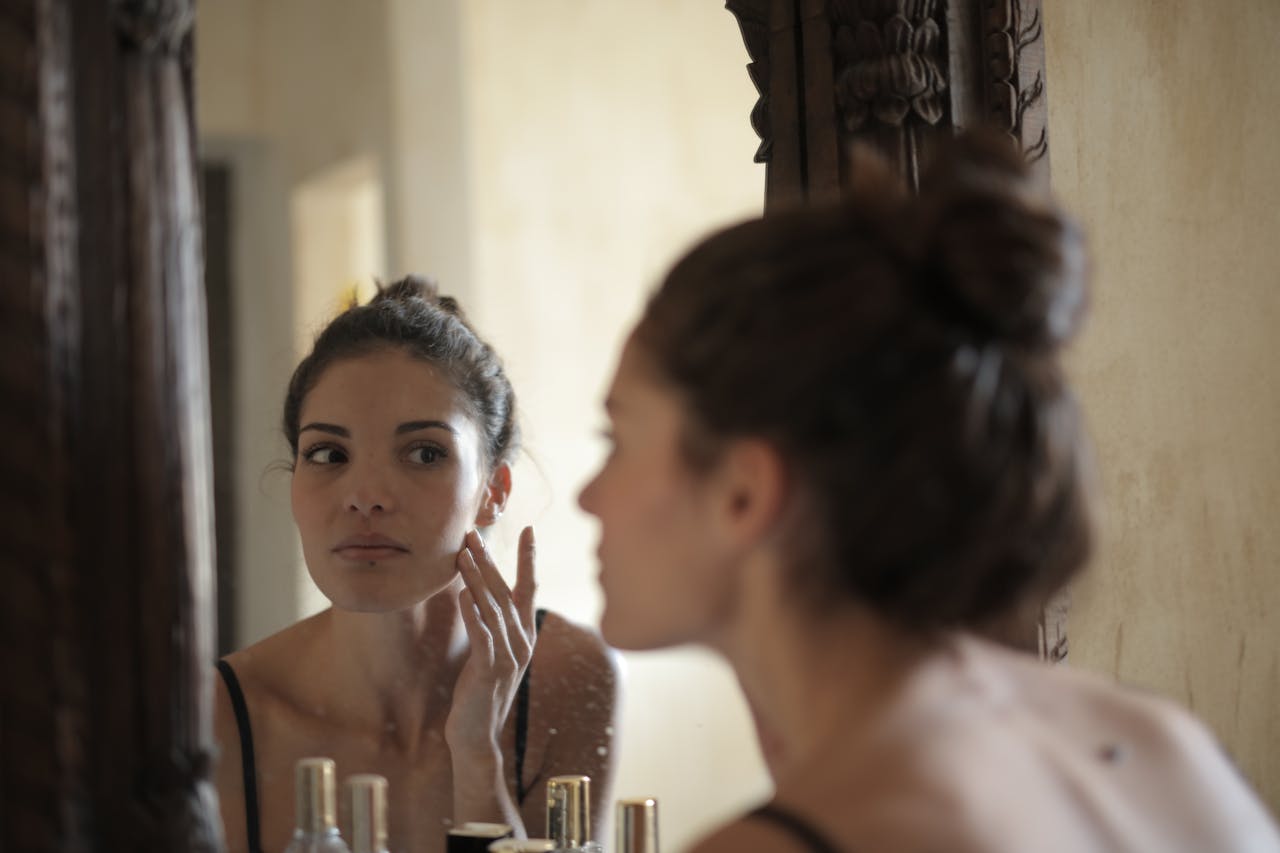Experiencing pilling on the skin can be a baffling and frustrating issue for many. This phenomenon occurs when skincare products clump and form small particles that can be felt and seen on the skin’s surface. Several factors contribute to skincare pilling, such as the type of ingredients used in products, the amount applied, and the method of application. It is essential to understand these aspects to prevent and address the undesired effect of products rolling off the skin.
The quality and compatibility of skincare products are important in determining whether they will pill upon application. Products with high concentrations of silicones or talc, for instance, are more prone to pilling because they tend to sit on top of the skin rather than being absorbed. Additionally, the order in which products are applied can have an impact; layering multiple products quickly without allowing each to absorb fully can lead to pilling.
Moreover, the physical condition of the skin itself plays a role. Skin that has not been properly exfoliated may have a build-up of dead skin cells, which creates an uneven surface for products to cling to and eventually pill. Ensuring routine exfoliation and giving time for skincare products to absorb fully before layering can significantly reduce the chances of pilling, leading to a smoother application and more effective skincare regimen.

I am a Nurse Practitioner licensed across multiple states, with experience in cardiology, nephrology, and family medicine. My current focus is on primary care, where I advocate for a holistic approach to healthcare, often recommending functional medicine to patients when suitable.
Understanding Skincare Pilling
Skincare pilling occurs when products do not absorb properly into the skin, leading to tiny balls or pills of product rolling off the surface. Pilling is similar to what one might experience with fabrics like sweaters.
Factors contributing to skincare pilling:
- Layering: Applying multiple products too quickly can cause them to sit on top of each other rather than absorb.
- Formula consistency: Thicker, more creamy formulas are more prone to pilling.
- Quantity used: Using too much product can overwhelm the skin’s ability to absorb.
- Skin texture: Uneven skin with dry patches or excess dead skin cells can hinder product absorption.
To prevent pilling, consider the following:
- Exfoliate: Regular exfoliation can smooth the skin’s surface.
- Patience: Allow each product to absorb fully before applying the next layer.
- Application method: Use a gentle hand and pat products into the skin rather than rubbing them in.
- Product Selection: Seek out products that are known to absorb well and complement each other.
Understanding the products’ ingredients and how they interact can also play a role in preventing pilling. For instance, water-based products should be applied before oil-based counterparts to facilitate better absorption. If pilling persists, reassessing the skincare routine with a professional may be necessary to ensure compatibility and proper application techniques.
Common Causes of Pilling
Skincare pilling occurs when products do not absorb or blend well on the skin. Below are specific causes that can lead to this frustrating phenomenon.
Incompatible Ingredients
Products with ingredients that don’t chemically mesh can result in pilling. For example, silicone-based primers may not agree with water-based foundations, leading to rolling or balling up when combined.
Over-Application of Products
Applying too much product can exceed the skin’s absorption capacity. Thin, even layers are key; heavy-handed application can create a surplus that the skin can’t absorb, causing pilling on the surface.
Incorrect Product Order
Applying skincare in the wrong sequence can hinder absorption. Water-based products should be applied before oil-based ones to ensure proper layering and prevent pilling.
Rapid Layering
The skin requires time to absorb each product. Rushing through your skincare routine without leaving time between applications diminishes absorption and increases the likelihood of pilling.
Product Formulation
Certain product formulations may not be conducive to layering and are more prone to pilling. Formulations that are too thick or contain high concentrations of polymers and fillers are often culprits.
Role of Skin Type in Pilling
Skin pilling can occur due to the interaction of skincare products with the natural composition of different skin types, resulting in small, unappealing balls of product on the skin’s surface.
Oily Skin Challenges
Individuals with oily skin may experience pilling more frequently because the excess sebum can cause skincare products to clump together rather than absorb properly. Layering multiple products without allowing sufficient time for each to penetrate can exacerbate this issue.
Dry Skin Issues
Conversely, those with dry skin may face pilling when the skin’s flaky and rough texture catches and rolls up the applied products. Insufficient exfoliation or hydration can worsen pilling for dry skin types, as dead skin cells accumulate and impede smooth application.
Techniques to Reduce Pilling
Skincare pilling can detract from the intended benefits of your routine. These specific techniques can help to reduce or prevent pilling, ensuring that products are absorbed effectively and work as intended.
Exfoliation
Regular exfoliation removes dead skin cells that could interfere with skincare product absorption. Utilize products containing alpha-hydroxy acids, such as glycolic acid, to help in breaking down the bonds between old cells and reveal smoother skin.
Proper Application Methods
The method of application is important. To minimize pilling, skincare items should be applied in thin layers. For example, wait for the first product to dry before applying the next. Additionally, patting products into the skin rather than rubbing can also help prevent pilling.
Allowing Absorption Time
Time between applications is important. Allow each layer of skincare product to be fully absorbed before adding another layer to prevent products from mixing and clumping on the surface of the skin.
Choosing the Right Products
Selecting compatible products can also reduce pilling. Some ingredients do not mix well together and can cause pilling when layered. Make sure to use products formulated to work in harmony when building your skincare regimen.
The Impact of Product Absorption
When skincare pills, the product may not be absorbing properly into the skin. Absorption can be affected by several factors:
- Texture and formulation: Thick, creamy products might struggle to penetrate the skin compared to lighter, water-based options.
- Skin preparation: Properly cleansed and exfoliated skin allows for better absorption.
- Application method: Gently pressing products into the skin might increase absorption versus vigorously rubbing them.
In skincare routines, the lack of product absorption leads to the formation of tiny skincare balls on the surface, known as pilling. This happens when excess product accumulates because the layers underneath didn’t absorb effectively. Ingredients that can cause pilling include:
- Silicones: Common in primers and moisturizers, silicones can create a barrier that may lead to pilling.
- Petroleum-based products: These can sit on top of the skin, trapping other products underneath.
To mitigate absorption issues, consider the following:
- Apply products in the correct order: Thinnest to thickest consistency.
- Allow time for each product to absorb before applying the next layer.
- Use gentle patting motions instead of rubbing.
It is important to note that individual skin types respond differently to products, and finding the right balance for one’s unique skin chemistry is key.
Importance of Skincare Routine
A consistent skincare routine is central for maintaining skin health and appearance. Adhering to a daily regimen not only clears impurities but also ensures that the skin is nourished and protected from environmental stressors.
Key benefits include:
- Hydration: Proper hydration through daily moisturizing prevents dryness and keeps skin soft and supple.
- Protection: Using sunscreen shields the skin from harmful UV rays, reducing the risk of premature aging and skin cancer.
- Cell turnover: Regular exfoliation helps to remove dead skin cells, promoting new cell growth for a brighter complexion.
Individuals should tailor their routine to their specific skin needs, as the skin can have different requirements based on type and condition. For instance, those with acne-prone skin may benefit from products containing salicylic acid, which can help to clear pores and reduce breakouts.
Incorporating antioxidants, such as those found in topical vitamin C, fights free radicals and can improve the skin’s natural healing processes. Similarly, using ingredients known to combat signs of aging can lead to more youthful skin over time.
When followed diligently, a skincare routine can prevent the common issue of pilling, which is when products do not absorb properly and roll off the skin. Ensuring that each product is fully absorbed before applying the next layer is critical for effectiveness and can prevent this frustration.
By meticulously selecting products and following a structured regimen, one sets the stage for healthy, resilient skin that looks and feels its best.
Tips for Preventing Pilling
When applying skincare products, encountering pilling can be frustrating. Pilling happens when products do not absorb properly and instead roll off the skin. Here are practical steps one can take to prevent this annoyance:
- Use Less Product: They should start with a pea-sized amount. Overloading the skin makes absorption difficult, resulting in pilling.
- Pat, Don’t Rub: Gently patting products into the skin can enhance absorption and reduce friction that contributes to pilling.
- Allow Drying Time: One should wait a few minutes between applying different layers to give each product time to absorb.
- Check Product Order: Apply products from thinnest to thickest texture. This technique helps with better absorption.
- Exfoliate Regularly: Removing dead skin cells improves absorption. They can consider alpha-hydroxy acids for smoother skin and enhanced product absorption.
You can also try the following:
By incorporating these methods into their skincare routine, they are more likely to enjoy the full benefits of their products without the frustration of pilling.
When to Consult a Dermatologist
Skincare pilling can be a frustrating experience. It occurs when products do not absorb into the skin but rather roll off in tiny balls. While often it can be addressed by adjusting your skincare routine, there are instances where consulting a dermatologist is advisable.
- Persistent Issues: If pilling continues despite changes to your skincare products or routine, a dermatologist can help determine underlying skin conditions.
- Skin Reactions: Should the skin exhibit signs of irritation, redness, or allergic reactions alongside pilling, professional guidance is necessary.
- Changes in Skin Texture: Major changes in how the skin feels, especially if accompanied by pilling, may indicate the need for professional assessment.
What a Dermatologist Can Do:
- Diagnose: Identify specific skin conditions that may be causing the pilling.
- Recommendations: Provide product suggestions tailored to your skin’s needs.
- Treatment Plans: Establish treatments for any underlying skin issues.
When addressing skincare concerns, one should never hesitate to reach out to a dermatologist, especially if the problem persists or is accompanied by other symptoms. Professional advice ensures that skincare routines contribute to healthy and radiant skin, rather than complications.
Alternatives to Common Pilling Products
When a skincare product pills, it can be frustrating. The pilling effect often happens when products do not absorb well into the skin or when they clash with others in a routine. To avoid pilling, one can opt for products that have a lighter consistency or those that are formulated to be more easily absorbed by the skin.
Lighter Moisturizers
Instead of heavy creams, consider gels or lotions. These lighter options absorb quickly and are less likely to pill.
- Gel moisturizers: Suitable for oily or combination skin, offering hydration without heaviness.
- Lotion moisturizers: Normally less rich than creams and good for normal to mildly dry skin.
Serums
Serums are a great alternative because they have a high concentration of active ingredients and a thinner consistency.
- Hyaluronic acid serums: Hydrate the skin deeply and are typically well-absorbed.
Exfoliants
Opt for chemical exfoliants over physical ones to minimize the risk of pilling.
- AHAs and BHAs: These help to gently exfoliate the skin without the physical abrasion that can contribute to pilling.
Sunscreen
Physical sunscreens can sometimes pill, so a chemical sunscreen might be a more suitable alternative.
- Chemical sunscreens: They tend to be thinner and can be applied without leaving a thick residue that pills.
To integrate these alternatives into a skincare routine, they should be applied in order from thinnest to thickest consistency, allowing each product to absorb before applying the next. This method reduces the chances of pilling and enhances the effectiveness of the skincare regimen.
Synthetic vs. Natural Ingredients
When tackling the issue of skincare pilling, the composition of ingredients within products plays a pivotal role. Synthetic ingredients are engineered in laboratories to mimic natural compounds or to create entirely novel substances. These ingredients are often designed to improve product stability, longevity, and consistency. For instance, silicones in primers provide a silky texture and allow for smooth application but can contribute to pilling if layered with incompatible ingredients.
On the other hand, natural ingredients are derived directly from plants and other organic materials. They are preferred by some individuals for their perceived gentleness and ecological sustainability. However, their variability in composition can sometimes lead to inconsistent product performance.
It’s essential to note that both synthetic and natural ingredients can be the culprits of pilling. Pilling occurs when products do not absorb fully into the skin or are incompatible with one another, causing them to roll off the skin in small bobbles. Consumers should pay attention to the order of application and allow time for absorption between each product layer, regardless of the ingredient origin. Additionally, a science-backed approach is helpful in determining product quality and skin compatibility, rather than solely focusing on whether an ingredient is synthetic or natural.
Product Recommendations
When tackling skincare pilling, choose products that complement each other in terms of their formulations and ingredients. Here are some recommended products to prevent pilling:
- Primers: Silicone-based primers can create a smooth base that allows products to glide on without clumping. For example, the NYX Professional Makeup Studio Perfect Primer.
- Moisturizers: Select a moisturizer based on your skin type. For oily skin, lightweight, oil-free moisturizers like Neutrogena Hydro Boost Water Gel are ideal, whereas for dry skin, richer creams like CeraVe Moisturizing Cream work effectively.
- Sunscreens: A non-greasy, fast-absorbing sunscreen is essential. Consider using EltaMD UV Clear Facial Sunscreen for its compatibility with various skin types and smooth application.
Serums and face oils should be applied sparingly, and it’s important to let each product absorb fully before layering the next. Individuals can test the interaction between their products by doing a patch test on their arm.
Recommendations are based on compatibility and prevention of pilling. Consumers should assess product suitability based on individual skin concerns.
Frequently Asked Questions
In this section, readers will find targeted answers to commonly asked questions about skincare pilling, offering clarity and practical solutions to this frustrating issue.
How can I prevent pilling when applying skincare products?
To prevent pilling, one should wait for each skincare product to absorb fully before applying the next layer. It’s also beneficial to use less product and to gently pat it into the skin rather than rubbing vigorously.
What are the common reasons for skincare products to pill on the skin?
Skincare pilling often occurs when products are not compatible with each other, when too much product is applied, or when the products are not fully absorbed into the skin before layering.
Can layering different skincare products lead to pilling?
Yes, layering multiple skincare products without allowing them to fully absorb can lead to pilling, especially if the products have different bases, such as water-based and oil-based.
How does the order of skincare product application affect pilling?
The order of application can greatly affect pilling; lighter, water-based products should typically be applied before thicker, oil-based ones to enable proper absorption and minimize the risk of pilling.
What types of skincare ingredients are more prone to cause pilling?
Ingredients such as silicones, mineral oil, and certain thickening agents are more prone to cause pilling due to their formulations, which may not penetrate the skin as readily as other ingredients.
Are there specific skincare application techniques to reduce pilling?
To reduce pilling, one should apply skincare products with a light touch, patting rather than rubbing, and allow time between each product application. Using fewer products with simpler formulas may also help.

